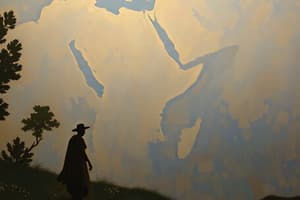Podcast
Questions and Answers
What geographical feature is Mesopotamia named after?
What geographical feature is Mesopotamia named after?
- Rivers (correct)
- Mountain ranges
- Deserts
- Fertile plains
What was the primary agricultural innovation developed by ancient Mesopotamians?
What was the primary agricultural innovation developed by ancient Mesopotamians?
- Selective breeding
- Crop rotation
- Irrigation (correct)
- Terracing
Which area is NOT one of the three general regions associated with early Mesopotamian civilization?
Which area is NOT one of the three general regions associated with early Mesopotamian civilization?
- Babylonia (correct)
- Sumer
- Assyria
- Akkad
What was a key characteristic of Mesopotamian religion?
What was a key characteristic of Mesopotamian religion?
How did Mesopotamians view their relationship with the gods?
How did Mesopotamians view their relationship with the gods?
What geographic area is Mesopotamia located in?
What geographic area is Mesopotamia located in?
What was the primary reason for the overflow of the Tigris and Euphrates rivers?
What was the primary reason for the overflow of the Tigris and Euphrates rivers?
What agricultural technique did Mesopotamian farmers use to manage crops?
What agricultural technique did Mesopotamian farmers use to manage crops?
Which civilization is credited as the earliest in Mesopotamia?
Which civilization is credited as the earliest in Mesopotamia?
How many gods and goddesses did the Mesopotamians identify?
How many gods and goddesses did the Mesopotamians identify?
What characterizes the religion of ancient Mesopotamia?
What characterizes the religion of ancient Mesopotamia?
What was the expected role of humans in relation to the gods in Mesopotamian belief?
What was the expected role of humans in relation to the gods in Mesopotamian belief?
What was a result of the ample food supply in Mesopotamia?
What was a result of the ample food supply in Mesopotamia?
Which feature is associated with the geographical location of Mesopotamia?
Which feature is associated with the geographical location of Mesopotamia?
Which term describes the land of Mesopotamia?
Which term describes the land of Mesopotamia?
Study Notes
Mesopotamia: The Land Between the Rivers
- Mesopotamia, meaning "land between the rivers," refers to the valley between the Tigris and Euphrates Rivers.
- Located at the eastern end of the Fertile Crescent, an arc of land stretching from the Mediterranean Sea to the Persian Gulf.
- The fertile soil and abundant crops sustained an early civilization.
- Mesopotamian soil was enriched by layers of silt deposited by the two rivers.
- The Tigris and Euphrates rivers often overflowed their banks during late spring, depositing fertile silt.
- These floods were unpredictable, depending on the melting of snows in the upland mountains where the rivers originated.
- To control the flow of rivers, ancient Mesopotamians utilized irrigation and drainage ditches.
- Regular crop growth due to controlled irrigation allowed for the rise of cities and civilizations.
Mesopotamian Religion
- Mesopotamian people relied on religion to understand life.
- Powerful deities, including gods and goddesses, were believed to permeate the universe.
- The Mesopotamians recognized nearly three thousand gods and goddesses.
- Their belief in numerous gods makes their religion polytheistic.
- Humans were expected to obey and serve the gods.
- Humans were considered inferior to the gods.
- The actions of the gods towards humans were unpredictable.
Mesopotamia
- Located in the valley between the Tigris and Euphrates Rivers
- Was the eastern end of the Fertile Crescent, an arc of land from the Mediterranean Sea to the Persian Gulf
- Fertile soil and abundant crops allowed for the development of early civilization.
- Mesopotamia had little rain, but the soil was enriched by layers of silt deposited by the rivers
- The Tigris and Euphrates often overflowed their banks in late spring, depositing fertile silt.
- These floods were unpredictable, depending on the melting of snows in the upland mountains where the rivers began.
- People in ancient Mesopotamia learned to control the flow of the rivers through irrigation and drainage ditches, enabling regular crop growth.
- An abundance of food allowed for the growth of cities and the emergence of civilization.
Mesopotamian Civilization
- Included achievements from Assyria, Akkad, and Sumer
- The Sumerians were the creators of the first Mesopotamian Civilization
Mesopotamian Religion
- People looked to religion to answer questions about life
- Powerful spiritual beings (gods and goddesses) were believed to permeate all aspects of the universe
- The Mesopotamians recognized nearly three thousand gods and goddesses
- Their religion was polytheistic because of this belief in many gods.
- Humans were supposed to obey and serve the gods.
- Humans were considered inferior to the gods and could never be sure what the gods might do to or for them.
Studying That Suits You
Use AI to generate personalized quizzes and flashcards to suit your learning preferences.
Description
Explore the fascinating region of Mesopotamia, known as the 'land between the rivers.' This quiz delves into its geographical significance, the impact of the Tigris and Euphrates rivers on agriculture, and the integral role of religion in Mesopotamian life and culture. Test your knowledge of this ancient civilization!




